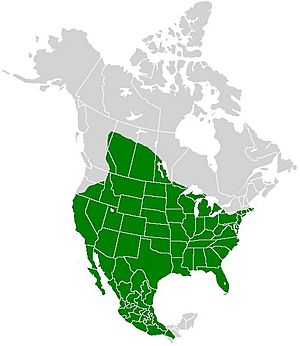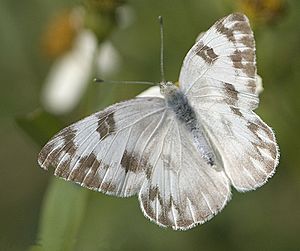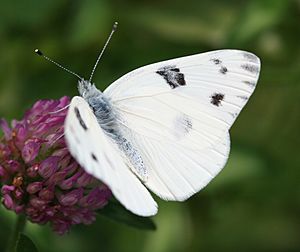Checkered white facts for kids
Quick facts for kids Checkered white |
|
|---|---|
 |
|
| Underside of the female | |
| Conservation status | |
| Scientific classification | |
 |
|
| Synonyms | |
|
The Pontia protodice, also known as the checkered white or southern cabbage butterfly, is a common butterfly found in North America. It belongs to the Pieridae family, which includes many white and yellow butterflies. Its green caterpillar is a type of cabbage worm, known for eating cabbage plants.
Contents
What Does It Look Like?
The top side of this butterfly's wings is white. It has black and gray markings. Females usually have more markings than males. The underside of their back wings has many yellow-brown lines. These butterflies have a wingspan of about 1.25 to 1.75 inches (3.2 to 4.4 cm).
When they are young, their eggs are orange. The caterpillars are bluish-green to gray with black dots. They also have yellow stripes along their back and sides. Before becoming an adult butterfly, they turn into a pupa. This pupa can be blue-gray or cream-colored and stays like that over winter.
Where Do They Live?
Checkered white butterflies are most often found in the southern parts of the United States. They also live in some northern areas of Mexico. Sometimes, you can spot them in the northern U.S. and southern Canada.
However, they are not found in the Pacific Northwest or the New England area. Their numbers have become less predictable east of the Appalachian Mountains. These butterflies are most common in late summer and autumn, rather than earlier in the year.
Where Do They Like to Live?
These butterflies prefer open areas. This includes deserts, plains, and places where the land has been changed by people. You can often find them in empty lots, near railroads, at airports, in dry grasslands, and even in cities.
Sometimes, they live in lightly wooded areas, grasslands, and meadows. This is usually in places that don't have a lot of shade. Even though they seem to live in many different places, they have sometimes disappeared from certain areas for many years.
What Do They Eat?
Adult checkered white butterflies drink nectar from flowers. They have been seen feeding on:
- Mustard plants
- Composite flowers (like daisies or sunflowers)
- Alfalfa
What Plants Do Their Babies Eat?
Female checkered white butterflies lay their eggs on specific plants. These are called "host plants." When the eggs hatch, the caterpillars eat these plants. Some of their favorite host plants include:
- Brazos rockcress (Arabis petiolaris)
- Sicklepod (Senna obtusifolia)
- Black mustard (Brassica nigra)
- Broccoli (Brassica oleraceae italica)
- Brussels sprouts (Brassica oleraceae gemmifera)
- Cabbage (Brassica oleraceae capitata)
- Cauliflower (Brassica oleraceae botrytis)
- Turnip (Brassica rapa)
- Pinnate tansy-mustard (Descurainia pinnata)
- Flixweed tansy-mustard (Descurainia sophia)
- Prairie pepperweed (Lepidium densiflorum)
- Virginia pepper-grass (Lepidium virginicum)
- Radish (Raphanus sativus)
- Tumble mustard (Sisymbrium altissimum)
- Field pennycress (Thlaspi arvense)
How Do They Behave?
Helping the Next Generation
Male checkered white butterflies give nutrients to the females when they mate. These nutrients are like a special protein gift. Females can use this protein to make eggs and to stay healthy while they search for places to lay their eggs. This is a way the male helps ensure the survival of their offspring.
Female Approaches
Male butterflies are usually very good at finding females. Because of this, it's rare for a female to try and get a male's attention. However, female checkered whites have been seen actively flying towards and even chasing both male and female butterflies of their own kind.
When a female chases another female, it only lasts a few seconds. But when she chases a male, she is likely trying to get him to mate with her. As a female flies around, feeding and looking for egg-laying spots, the nutrients she received from a male start to run out. After about 5 to 7 days, she becomes interested in mating again.
Both females who have never mated and those who have mated before might try to get a male's attention. Females who haven't mated might do this because they are hard to spot when they are resting. Females who have mated before might do it because they are less attractive to males. By approaching males, they try to have more chances to reproduce. Sometimes, females also leave crowded areas to avoid too many males. Then they have to actively look for males in a new place.
Sunbathing for Flight
Checkered white butterflies need their bodies to be warm, about 30-40 degrees Celsius (86-104 degrees Fahrenheit), to be able to fly. They get warm by facing the sun in a special way.
These butterflies use a behavior called "reflectance basking." This means they use their wings like tiny solar reflectors. They position their back towards the sun and hold their wings open at an angle. This helps their white wings reflect sunlight onto their bodies, warming them up so they can fly.






